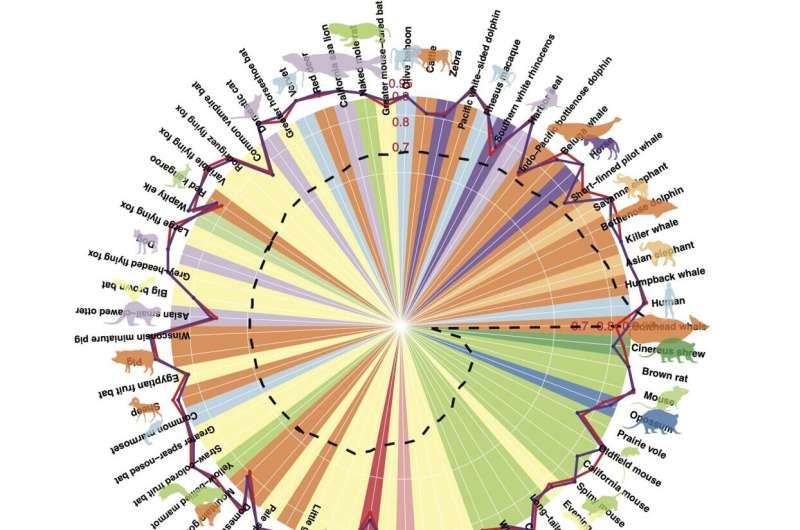This article has been reviewed according to Science X's editorial process and policies. Editors have highlighted the following attributes while ensuring the content's credibility:
fact-checked
peer-reviewed publication
trusted source
proofread
Global consortium creates database and universal 'clock' to estimate age in all mammalian tissues

Scientists at UCLA David Geffen School of Medicine and UCLA Health led an international research team that published two articles detailing changes in DNA—changes that researchers found are shared by humans and other mammals throughout history and are associated with life span and numerous other traits.
"We've discovered that the life spans of mammals are closely associated with chemical modifications of the DNA molecule, specifically known as epigenetics, or more accurately, methylation. In essence, mammals with longer life spans exhibit more pronounced DNA methylation landscapes, whereas those of shorter-lived species have more subdued, flatter methylation patterns," said the senior author of both articles, Steve Horvath, Ph.D., ScD, an expert on the aging process and a professor in human genetics and biostatistics at UCLA at the time the studies were conducted.
Jason Ernst, a professor of biological chemistry, computer science, and computational medicine at UCLA, said, "The technology we designed to measure DNA methylation levels across mammals along with the tissue sample contributions from a large consortium of researchers led to the production of a highly unique data set, which, when analyzed with advanced computational and statistical tools, unveiled a deeper understanding of the relationship between DNA methylation, life span, aging, and other biological processes across mammals."
The studies, one published in Science and the other in Nature Aging, focus on DNA methylation, or cytosine methylation, a chemical modification of cytosine, one of the four building blocks of the DNA molecule.
DNA methylation is a mechanism by which cells can control gene expression—turning genes on or off. In these studies, the researchers focused on DNA methylation differences across species at locations where the DNA sequence is generally the same.
To study the effects of DNA methylation, the nearly 200 researchers—collectively known as the Mammalian Methylation Consortium—collected and analyzed methylation data from more than 15,000 animal tissue samples covering 348 mammalian species. They found that changes in methylation profiles closely parallel changes in genetics through evolution, demonstrating that there is an intertwined evolution of the genome and the epigenome that influences the biological characteristics and traits of different mammalian species.
Among the Science study's findings:
- Methylation, as evidenced by the epigenetic "marks" it leaves, bears a substantial correlation with maximum life span across mammalian species. Looking at methylation profiles on the DNA molecule as terrain with peaks and troughs, Horvath commented that species with long lives have prominent peaks and valleys, developed during extended gestation and development periods. In contrast, short-lived species have short gestation periods and rapid development, resulting in cells with a flatter, less-defined methylation landscape.
- Maximum life span of a species is associated with specific developmental processes, as suggested by the involvement of certain genes and genetic transcription factors.
- Cytosines whose methylation levels correlate with maximum life span differ from those that change with chronological age, suggesting that molecular pathways pertaining to average life span within a species are distinct from those determining the species' maximum life span.
- Evolution acts not only at the genetic level, but also at the epigenetic level. "Our results demonstrate that DNA methylation is subjected to evolutionary pressures and selection," said the authors, whose database has been made public for other researchers.
Horvath and the consortium researchers used a subset of the database to study the methylation profiles of 185 species of mammals. Identifying changes in methylation levels that occur with age across all mammals, they developed a "universal pan-mammalian clock," a mathematical formula that can accurately estimate age in all mammalian species. Results of this study are published in Nature Aging.
Horvath and a UCLA team introduced the concept of an epigenetic clock for age measurement, using human saliva samples, in 2011. Two years later, Horvath demonstrated that cytosine methylation enables the creation of a mathematical model for estimating age across all human tissues. The new work, which describes universal clocks, demonstrates that a single formula can accurately estimate age across mammalian tissues and species.
Among the Nature Aging study's findings:
- The pan-mammalian clocks maintain their high accuracy across species with varying life spans, from short-lived mice and rats to long-lived humans, bats and whales.
- The universal pan-mammalian clocks are predictors of mortality risk in humans and mice, which suggests they could prove valuable for preclinical studies. Therefore, an intervention that reverses epigenetic age in a mouse, according to the clock, might be applicable to humans as well.
- The study identified specific regions in the genetic material of cells that either gain or lose methylation with chronological age.
- The research revealed that developmental genes play a role in the functioning of epigenetic clocks.
- The research connects developmental pathways with chronological aging effects and tissue degradation. This refutes the long-standing belief that aging is driven solely by random cellular damage that accumulates over time. Instead, the epigenetic aspects of aging follow a predetermined "program."
- The discovery of the pan-mammalian clocks provides compelling evidence that aging processes are evolutionarily conserved—remaining consistent through time—and are closely linked with developmental processes across all mammalian species.
More information: Amin Haghani et al, DNA methylation networks underlying mammalian traits, Science (2023). DOI: 10.1126/science.abq5693. www.science.org/doi/10.1126/science.abq5693
A. T. Lu, Z. Fei, A. Haghani et al. Universal DNA methylation age across mammalian tissues. Nature Aging (2023). DOI: 10.1038/s43587-023-00462-6




















